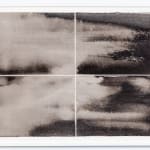James Little USA, b. 1952
Untitled, 2014
Ink on paper
22 x 30 in
55.9 x 76.2 cm
55.9 x 76.2 cm
8097
Further images
This work on paper by James Little (b. 1952, USA) offers a glimpse into the experimental side of the artist’s practice. A highly skilled painter known for making his own...
This work on paper by James Little (b. 1952, USA) offers a glimpse into the experimental side of the artist’s practice. A highly skilled painter known for making his own mediums from scratch, Little prioritizes mastery and technique. His compositions express the highest understanding of medium specificity, and the utmost respect for visibility of the artist’s hand. This ink on paper work demonstrates all of these key elements. A methodical grid separates the otherwise gestural composition into a minimal grid, while the ink is allowed to express the interplay between opacity and translucency that is fundamental to its properties as a medium.
Though nuanced in its expression of such, this composition is an excellent example of Little’s distinctive aesthetic language, which is rooted in geometric shapes and patterns, flat surfaces, and emotive color relationships. While developing his unique position within contemporary abstraction, he has devoted decades to rigorous academic study of color theory, pictorial design, and painting techniques. His practice embodies the complementary forces of simplicity and complexity.
Though nuanced in its expression of such, this composition is an excellent example of Little’s distinctive aesthetic language, which is rooted in geometric shapes and patterns, flat surfaces, and emotive color relationships. While developing his unique position within contemporary abstraction, he has devoted decades to rigorous academic study of color theory, pictorial design, and painting techniques. His practice embodies the complementary forces of simplicity and complexity.





